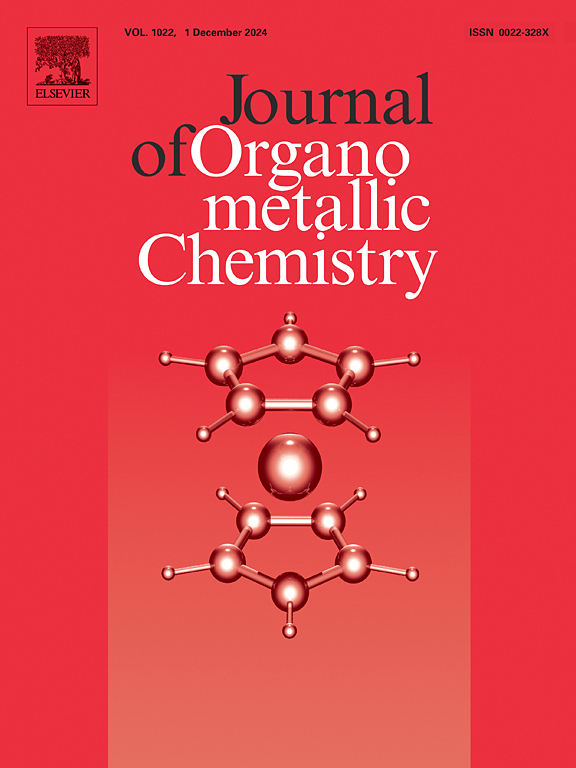含氟n杂环羰基和膦配体的铱(I)配合物对酮和醛的转移加氢催化
IF 2.1
3区 化学
Q3 CHEMISTRY, INORGANIC & NUCLEAR
引用次数: 0
摘要
介绍了四种铱配合物[Ir(COD)(NHC)PR3]SO3CF3 (COD = 1,5-环二烯;NHC = 1 -丁基- 3-(苄基)-咪唑-2-吡啶,R =苯基(1);NHC = 1 -丁基- 3-(2,3,4,5,6-五氟苯基)-咪唑-2-吡啶,R =苯基(2);NHC = 1 -丁基- 3-(苄基)-咪唑-2-吡啶,R = 4-氟苯基(3);NHC =前体配合物[Ir(COD)(NHC)Cl] (NHC = 1 -丁基- 3-(苄基)-咪唑-2-酰基(1a)或1 -丁基- 3-(2,3,4,5,6-五氟苯基)-咪唑-2-酰基,(2a))中的1 -丁基- 3-(2,3,4,5,6-五氟苯基)-咪唑-2-酰基)。对配合物1和2作为酮类和醛类转移氢化反应的催化剂进行了评价。含非氟化NHC配体的配合物1比配合物2更活跃。报道了两个配合物(1a和2)的x射线结构,证实了前驱体和阳离子碳配合物的成功制备。本文章由计算机程序翻译,如有差异,请以英文原文为准。
Iridium(I) complexes with fluorinated N-heterocyclic carbene and phosphine ligands for the transfer hydrogenation catalysis of ketones and aldehydes
We describe the synthesis and characterization of four iridium complexes [Ir(COD)(NHC)PR3]SO3CF3 (COD = 1,5-cyclooctadiene; NHC = 1‑butyl‑3-(benzyl)-imidazol-2-ylidine, R = phenyl (1); NHC = 1‑butyl‑3-(2,3,4,5,6-pentafluorobenzyl)-imidazol-2-ylidine, R = phenyl (2); NHC = 1‑butyl‑3-(benzyl)-imidazol-2-ylidine, R = 4-fluorophenyl (3); and NHC = 1‑butyl‑3-(2,3,4,5,6-pentafluorobenzyl)-imidazol-2-ylidine, R = 4-fluorophenyl (4)) from the precursor complexes [Ir(COD)(NHC)Cl] (NHC = 1‑butyl‑3-(benzyl)-imidazol-2-ylidine (1a) or 1‑butyl‑3-(2,3,4,5,6-pentafluorobenzyl)-imidazol-2-ylidine, (2a)), respectively. Complexes 1 and 2 were evaluated as catalysts for the transfer hydrogenation of ketones and aldehydes. Complex 1 with an NHC ligand that is not fluorinated is more active than complex 2. The X-ray structures of two complexes (1a and 2) are reported, confirming the successful preparation of both precursors and cationic carbene complexes.
求助全文
通过发布文献求助,成功后即可免费获取论文全文。
去求助
来源期刊

Journal of Organometallic Chemistry
化学-无机化学与核化学
CiteScore
4.40
自引率
8.70%
发文量
221
审稿时长
36 days
期刊介绍:
The Journal of Organometallic Chemistry targets original papers dealing with theoretical aspects, structural chemistry, synthesis, physical and chemical properties (including reaction mechanisms), and practical applications of organometallic compounds.
Organometallic compounds are defined as compounds that contain metal - carbon bonds. The term metal includes all alkali and alkaline earth metals, all transition metals and the lanthanides and actinides in the Periodic Table. Metalloids including the elements in Group 13 and the heavier members of the Groups 14 - 16 are also included. The term chemistry includes syntheses, characterizations and reaction chemistry of all such compounds. Research reports based on use of organometallic complexes in bioorganometallic chemistry, medicine, material sciences, homogeneous catalysis and energy conversion are also welcome.
The scope of the journal has been enlarged to encompass important research on organometallic complexes in bioorganometallic chemistry and material sciences, and of heavier main group elements in organometallic chemistry. The journal also publishes review articles, short communications and notes.
 求助内容:
求助内容: 应助结果提醒方式:
应助结果提醒方式:


